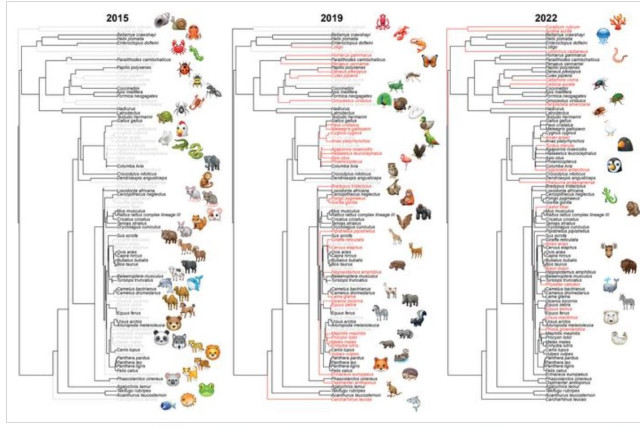Emojis don't reflect natural biodiversity, biologists complain

The researchers say that having access to biodiverse emojis is not just for sending jokes to each other, but crucial for online discussions of biodiversity and conservation.
The compilers of thousands of emoji images sent on WhatsApp have been discriminating against plants, fungi and microorganisms – which are poorly represented among them. The current emoji library doesn’t accurately represent the “tree of life” and the breadth of biodiversity seen in nature, according to an analysis just published in the journal iScience.
A team of conservation biologists categorized emojis related to nature and animals and mapped them onto the phylogenetic tree of life. They found that while dogs, cats, lions, cows, rabbits, monkeys, alligators, chickens, horses and many other animals are well represented by the current emoji catalog, plants, fungi, and microorganisms are almost nonexistent, according to Italian conservation biologists Stefano Mammola, Mattia Falaschi and Gentile Francesco Ficetola.
The researchers say that having access to biodiverse emojis is not just for sending jokes to each other, but crucial for online discussions of biodiversity and conservation. “What makes emojis so successful is their unique semantic and emotional connotation, which allows for direct, simple, and ultimately powerful communication. Exploring the uses of nature-related emojis in the context of biodiversity communication and conservation could be a topic for further research,” the researchers wrote.
“Within the animal kingdom, vertebrates were over-represented while arthropods were under-represented with respect to their actual biodiversity. The researchers argue that creating a more diverse and representative emoji catalog could aid conversations around biodiversity and its conservation in the digital era,” they wrote.
“While the biodiversity crisis may seem distant from the online world, in our increasingly digitized society, we should not underestimate the potential of emojis to raise awareness and foster appreciation for the diversity of life on Earth," they said. "The development and maintenance of diverse and inclusive emoji sets are crucial to ensure the equitable representation of the tree of life in digital communication tools and to effectively convey messages on the importance of all the organisms for the functioning of the biosphere.”
The team's assessment of emoji selection: "strong taxonomic bias"
The team categorized all of the emojis related to nature and animals available in Emojipedia (a curated online catalog of emojis) and then compared emoji biodiversity to real-world biodiversity. They also assessed how emoji biodiversity changed between 2015 and 2022 to determine whether the emoji catalog is evolving to better represent biodiversity as more emojis are added.
Overall, the team identified emojis representing 112 distinct organisms –92 animals, 16 plants, one fungus (likely Amanita muscaria), and 1 microorganism (likely Escherichia coli). “Such strong taxonomic bias is in line with current societal awareness of biodiversity, which tends to prioritize animals over other taxa.”
Next, the researchers examined the biodiversity characteristics of the animal emojis in more detail. In some cases, they were able to identify individual animal species (for example, the bald eagle and giant panda emojis), while other emojis were only identifiable to the genus or family level (for example, emojis that represent ants or crocodilians).
Overall, 76% of the animal emojis represented vertebrates, 16% represented arthropods, and 4%, 2%, and 1% represented mollusks (jellyfish, anemones, and corals) and annelids (earthworms, polychaete worms, and leeches) respectively. Given that there are 1,302,809 described species of arthropod and only 85,423 described species of vertebrate, this means that the current emoji catalog under-represents arthropod biodiversity and over-represents vertebrates.
The researchers also complained that there were no emojis representing either platyhelminths (flatworms, including tapeworms) or nematodes, despite there being more than 20,000 platyhelminth species and almost 20,000 nematode ones. These biases in the emoji representation of animal biodiversity reflect known biases in biodiversity assessments and conservation analyses.
The lack of underrepresented species could also be due to the criteria for judging potential emoji subjects – for something to become an emoji, it usually needs be Googled with a certain frequency, and many unrepresented organisms don’t meet this criterion.
“What makes emojis so successful is their unique semantic and emotional connotation, which allows for direct, simple, and ultimately powerful communication. This rule can be problematic, as it risks hampering the extension of emojis in order to better cover the actual biodiversity of our planet,” the researchers write.
However, emoji biodiversity does appear to be increasing. In 2015, there were only emojis for 45 animal taxa, but this increased to 78 in 2019 and 92 in 2022.
As well as increasing in number, animal emojis also became more representative of biodiversity over this time period. In 2015, there were only emojis representing vertebrates, arthropods, and mollusks, but annelids gained representation in 2020 with the addition of the “worm” emoji, which most likely represents an earthworm, and cnidarians gained representation in 2021 with the addition of a red coral emoji.
Jerusalem Post Store
`; document.getElementById("linkPremium").innerHTML = cont; var divWithLink = document.getElementById("premium-link"); if (divWithLink !== null && divWithLink !== 'undefined') { divWithLink.style.border = "solid 1px #cb0f3e"; divWithLink.style.textAlign = "center"; divWithLink.style.marginBottom = "15px"; divWithLink.style.marginTop = "15px"; divWithLink.style.width = "100%"; divWithLink.style.backgroundColor = "#122952"; divWithLink.style.color = "#ffffff"; divWithLink.style.lineHeight = "1.5"; } } (function (v, i) { });

